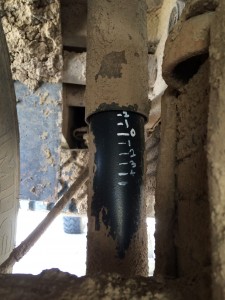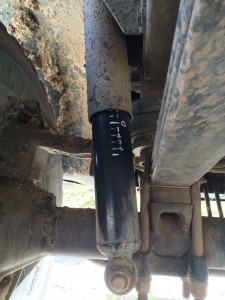I have worked out that the uneven tyre wear I have been getting is due to the truck not being balanced left to right. When the leaf spring is loaded, it moves the axle aft due to the shackle at the back of the spring. If both springs are loaded evenly this is not a problem. However, when one spring is loaded more than the other, it effectively ‘turns’ the axle, which causes increased, uneven, tyre wear. My rear tyres both wear more on the left, which shows that the axle has been ‘turned’ to the right, i.e. the right side has more load. At the front, the left tyre is more worn; this is because a steering correction is required to counter the rear axle (which is trying to turn the vehicle left, i.e. the rear to the right). To try and measure the amount of the imbalance, I have marked the 4 shock absorbers with a scale so I can read-off the springs’ compression.

 I have also taken into account the spacing blocks on the Daily 4×4 axles that make the right side of the vehicle chassis 10 mm lower than the left side. I will call this level (I have no idea why this is done).
I have also taken into account the spacing blocks on the Daily 4×4 axles that make the right side of the vehicle chassis 10 mm lower than the left side. I will call this level (I have no idea why this is done).
Main fuel tank full, long range tank empty, 40 litres in the fuel cans and the fresh and waste water tanks empty – the vehicle sits level
Main fuel tank full, long range tank empty, 40 litres in the fuel cans and the fresh water full and waste water tanks empty – the vehicle is lower on the right by 10 mm at the front and by 15 mm at the rear.
Main fuel tank full, long range tank full (115 litres), 40 litres in the fuel cans and the fresh water full and waste water tanks empty – the vehicle is lower on the right by 3 mm at the front and by 8 mm at the rear.
As you can see from above, the combination of full water and an empty long range tank can lead to quite a lean and therefore, increased uneven tyre wear. With the long range tank full it does counter-balance the weight of the water, which levels the truck a little.
I have also experimented with varying the air pressure of the air suspension across the axles.
1 bar difference across an axle gives a correction of 5 mm.
2 bar difference across an axle gives a correction of 15 mm.
Therefore, I now use these adjustments to level the truck:-
With low water and empty long range tank I now set the air suspension:- Front left 2 bar, front right 2 bar, rear left 3 bar, rear right 3 bar (this has always been my normal setting).
With full water and empty long range tank I now set the air suspension:- Front left 1 bar, front right 2 bar, rear left 1 bar, rear right 3 bar.
With full water and a full long range tank I now set the air suspension:- Front left 2 bar, front right 2 bar, rear left 2 bar, rear right 3 bar.
I am trying to avoid operating the air suspension above 3 bar as I don’t want to overload the chassis. The air bags are rated to operate at a maximum of 7 Bar with a burst pressure of >20 Bar!
For interest, the front air bag produces 1.16 kN (about 118 kg) each per 1 bar and the rear air bags produce 1.43 kN (about 146 kg) each per 1 bar.
